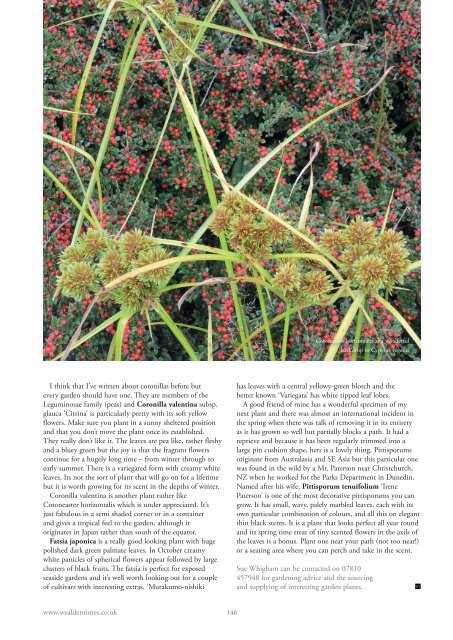Wealden Times | WT164 | October 2015 | Food supplement inside
Wealden Times - The lifestyle magazine for the Weald
Wealden Times - The lifestyle magazine for the Weald
You also want an ePaper? Increase the reach of your titles
YUMPU automatically turns print PDFs into web optimized ePapers that Google loves.
Cotoneaster horizontalis as a wonderful<br />
backdrop to Cyperus vegetus<br />
I think that I’ve written about coronillas before but<br />
every garden should have one. They are members of the<br />
Leguminosae family (peas) and Coronilla valentina subsp.<br />
glauca ‘Citrina’ is particularly pretty with its soft yellow<br />
flowers. Make sure you plant in a sunny sheltered position<br />
and that you don’t move the plant once its established.<br />
They really don’t like it. The leaves are pea like, rather fleshy<br />
and a bluey green but the joy is that the fragrant flowers<br />
continue for a hugely long time – from winter through to<br />
early summer. There is a variegated form with creamy white<br />
leaves. Its not the sort of plant that will go on for a lifetime<br />
but it is worth growing for its scent in the depths of winter.<br />
Coronilla valentina is another plant rather like<br />
Cotoneaster horizontalis which is under appreciated. It’s<br />
just fabulous in a semi shaded corner or in a container<br />
and gives a tropical feel to the garden, although it<br />
originates in Japan rather than south of the equator.<br />
Fatsia japonica is a really good looking plant with huge<br />
polished dark green palmate leaves. In <strong>October</strong> creamy<br />
white panicles of spherical flowers appear followed by large<br />
clusters of black fruits. The fatsia is perfect for exposed<br />
seaside gardens and it’s well worth looking out for a couple<br />
of cultivars with interesting extras. ‘Murakumo-nishiki<br />
has leaves with a central yellowy-green blotch and the<br />
better known ‘Variegata’ has white tipped leaf lobes.<br />
A good friend of mine has a wonderful specimen of my<br />
next plant and there was almost an international incident in<br />
the spring when there was talk of removing it in its entirety<br />
as it has grown so well but partially blocks a path. It had a<br />
reprieve and because it has been regularly trimmed into a<br />
large pin cushion shape, hers is a lovely thing. Pittisporums<br />
originate from Australasia and SE Asia but this particular one<br />
was found in the wild by a Mr. Paterson near Christchurch,<br />
NZ when he worked for the Parks Department in Dunedin.<br />
Named after his wife, Pittisporum tenuifolium ‘Irene<br />
Paterson’ is one of the most decorative pittisporums you can<br />
grow. It has small, wavy, palely marbled leaves, each with its<br />
own particular combination of colours, and all this on elegant<br />
thin black stems. It is a plant that looks perfect all year round<br />
and its spring time treat of tiny scented flowers in the axils of<br />
the leaves is a bonus. Plant one near your path (not too near!)<br />
or a seating area where you can perch and take in the scent.<br />
Sue Whigham can be contacted on 07810<br />
457948 for gardening advice and the sourcing<br />
and supplying of interesting garden plants.<br />
www.wealdentimes.co.uk<br />
146


















